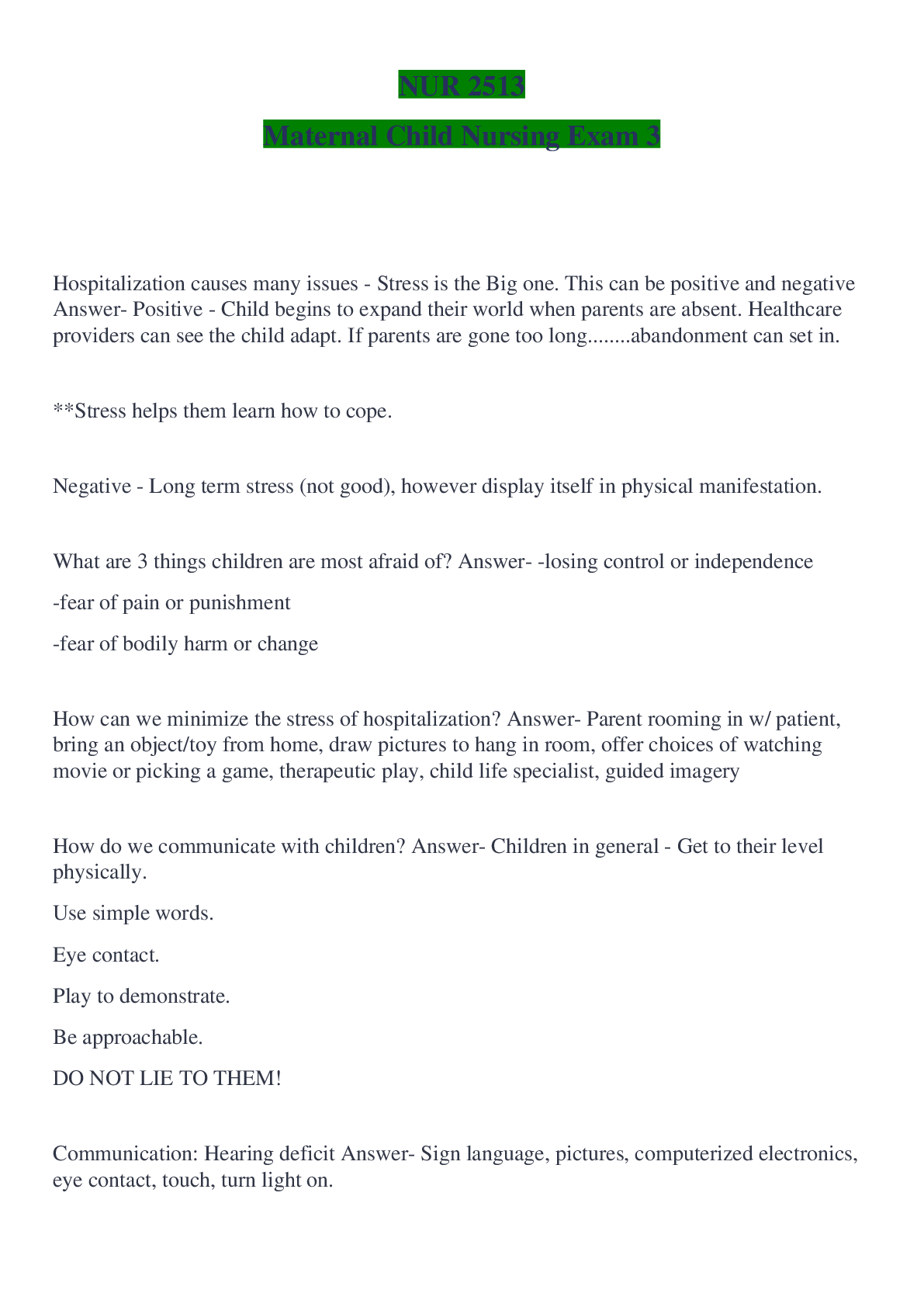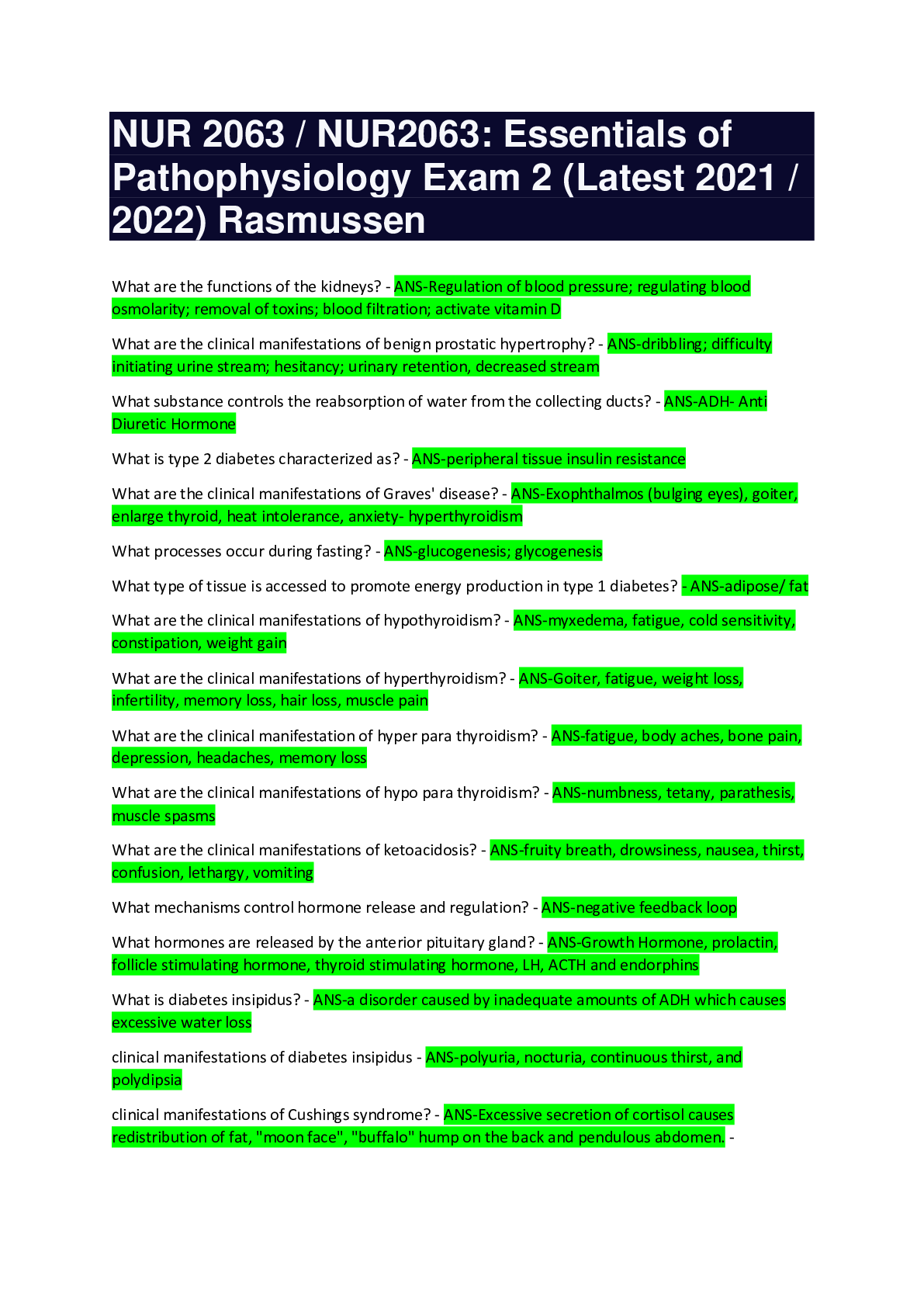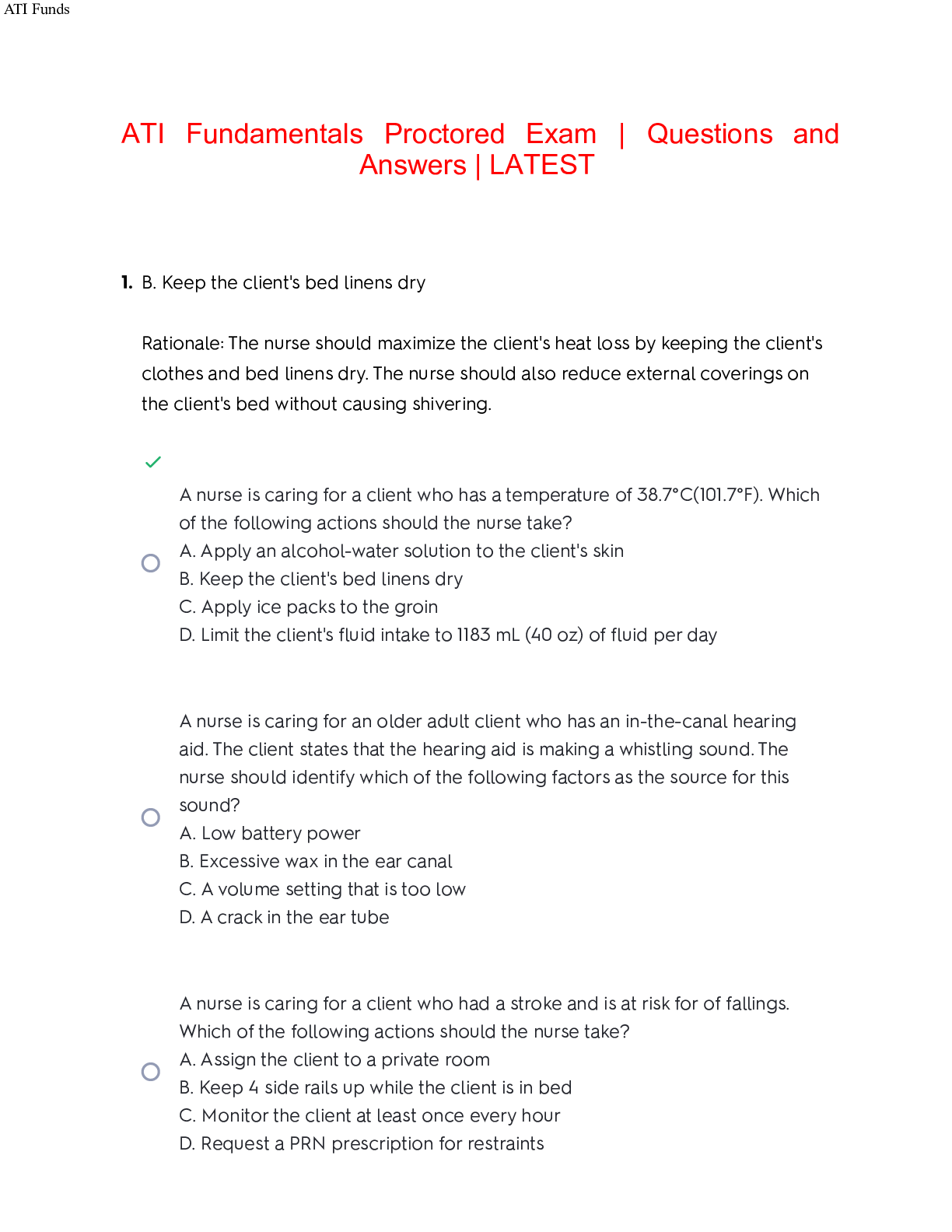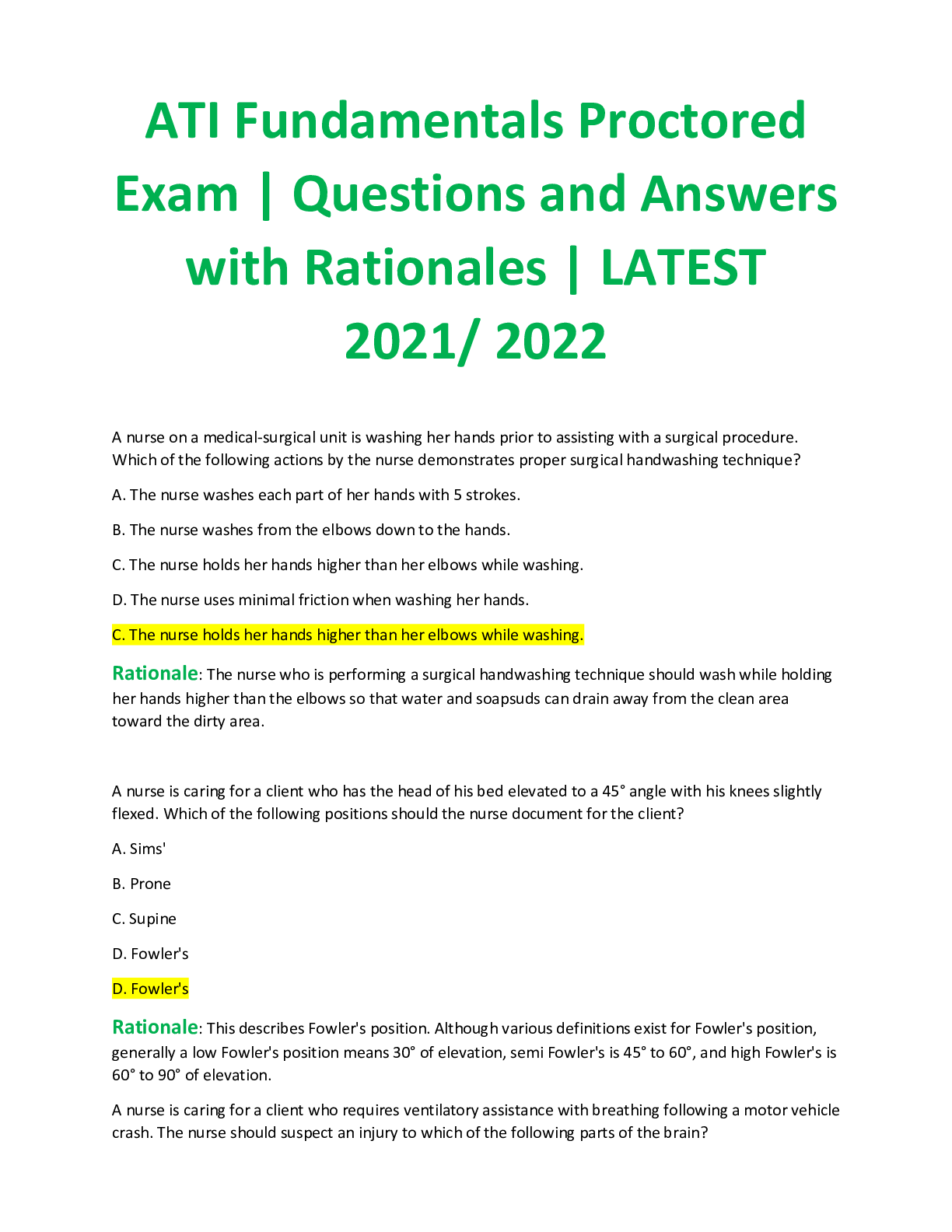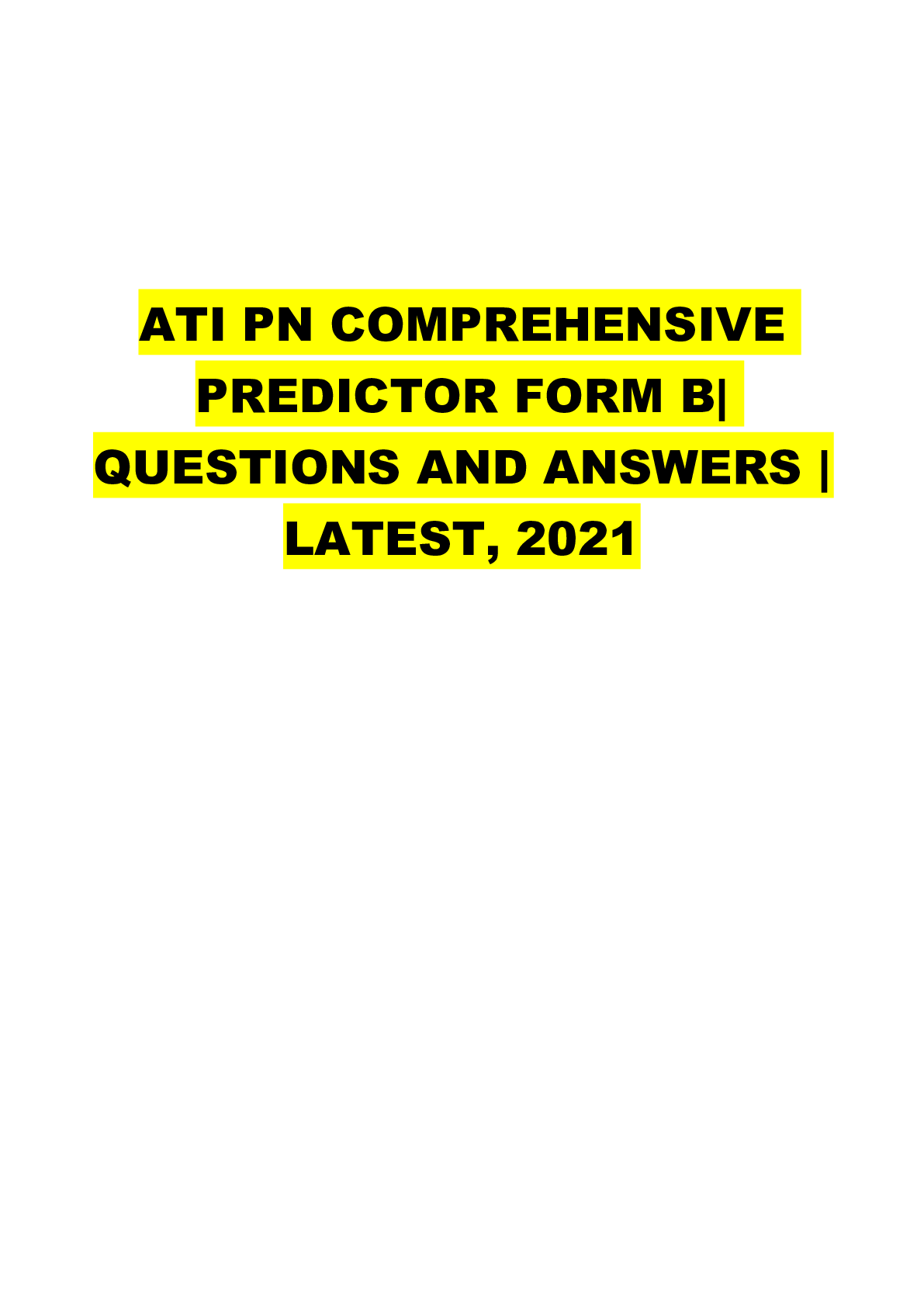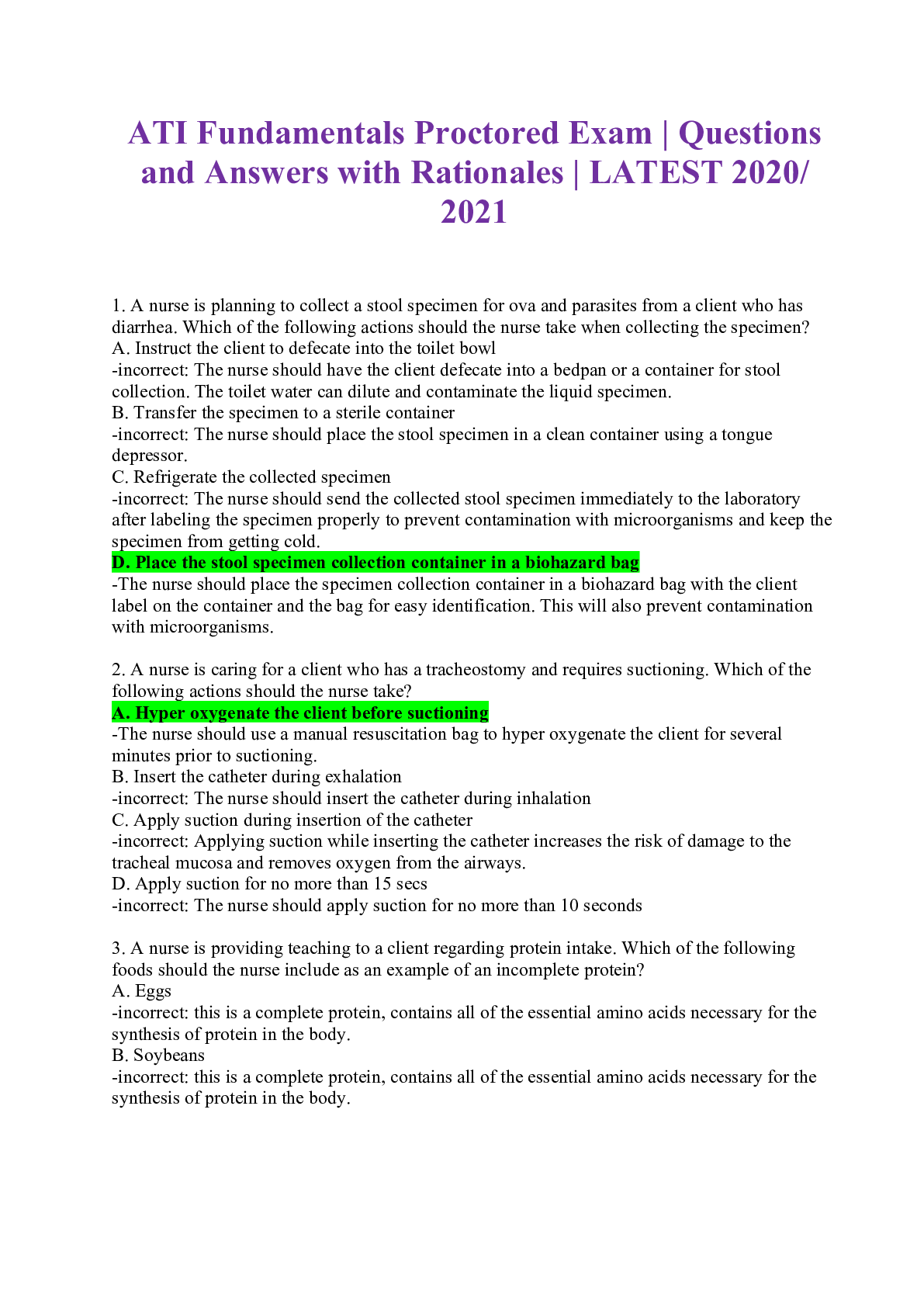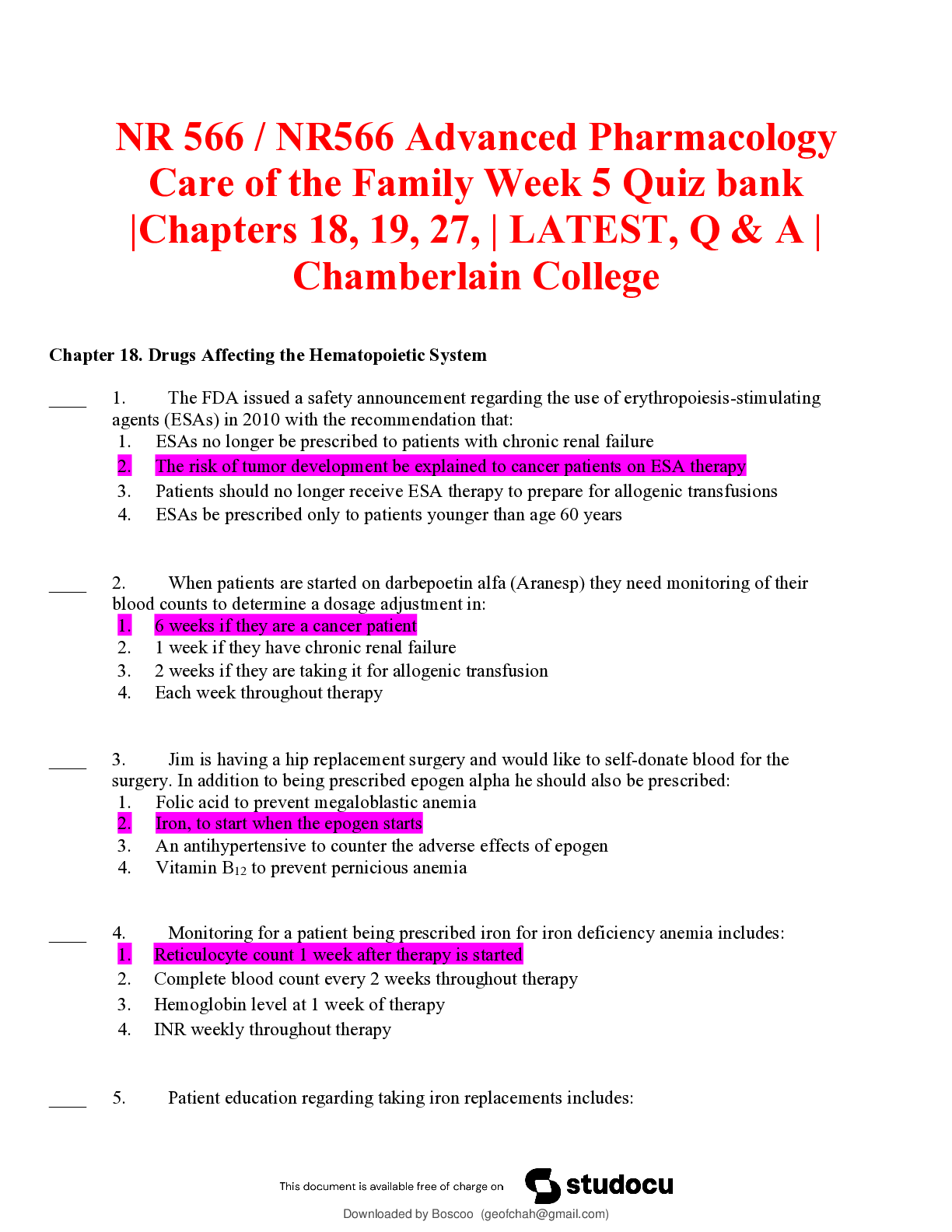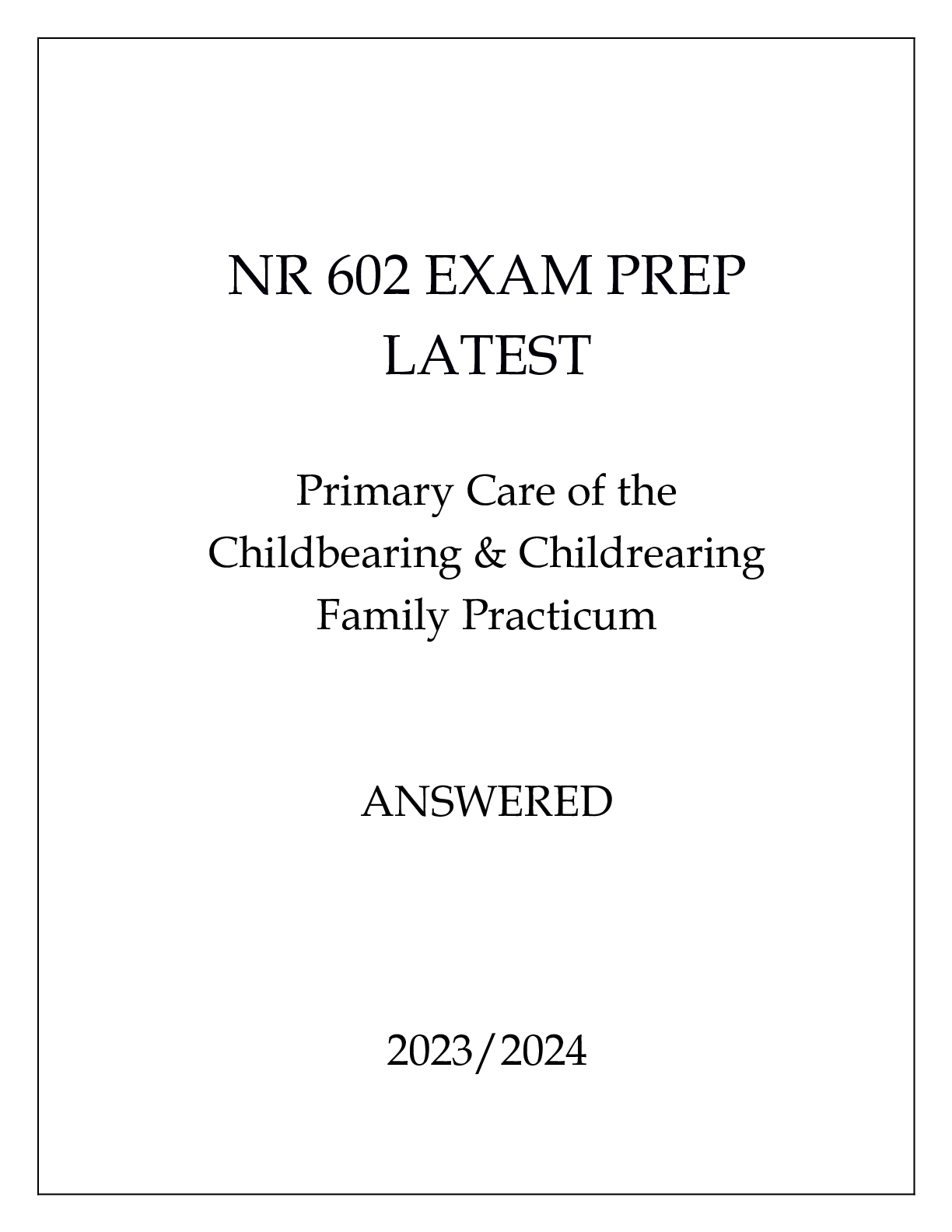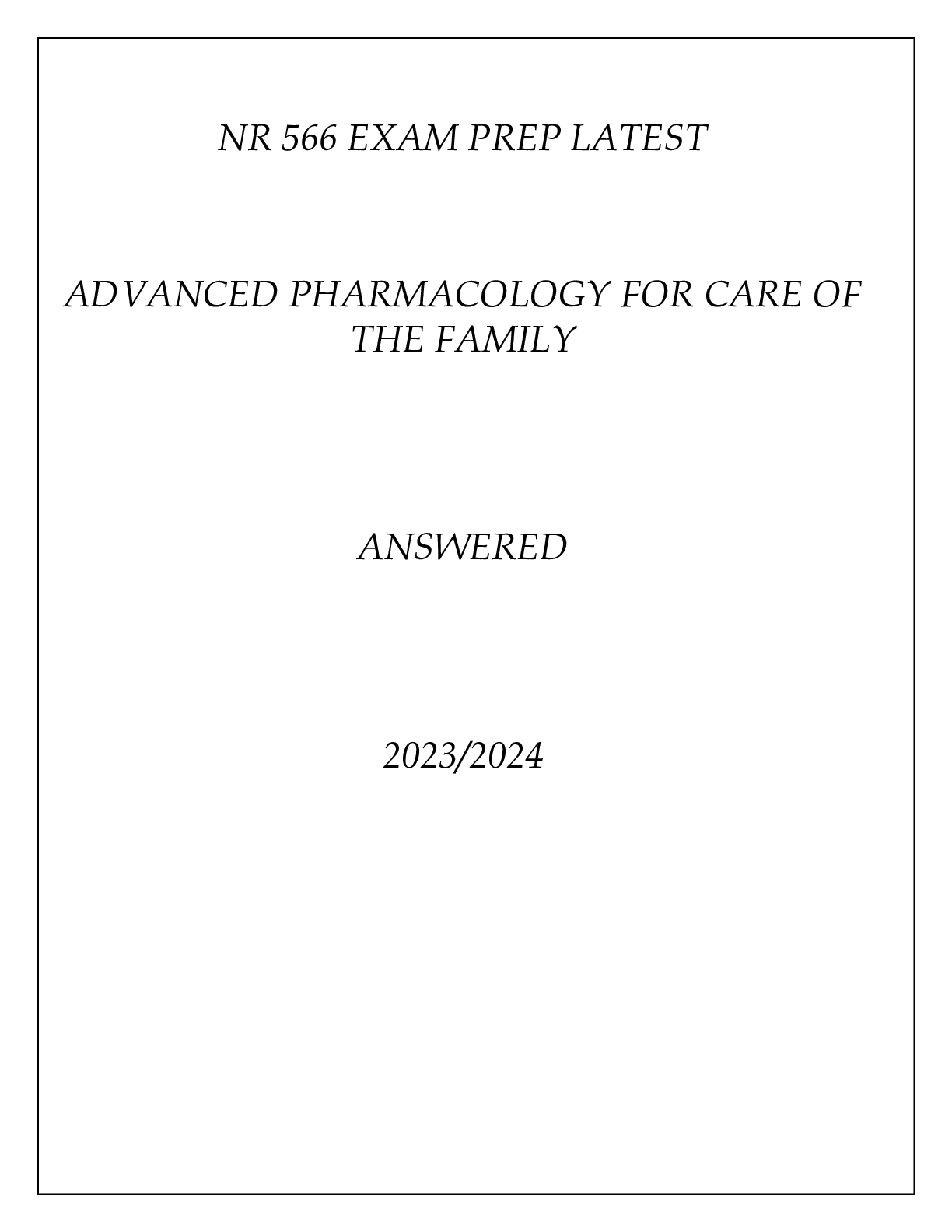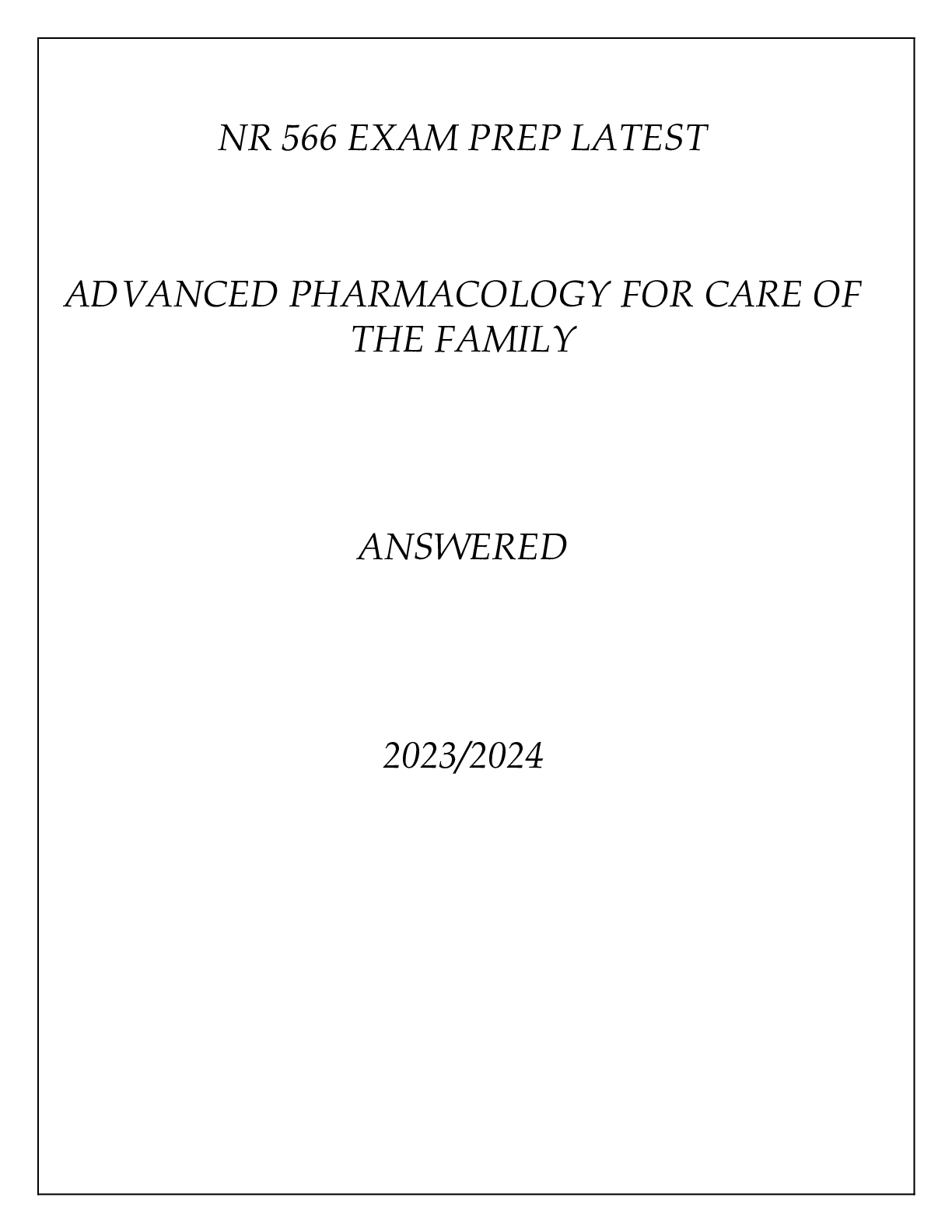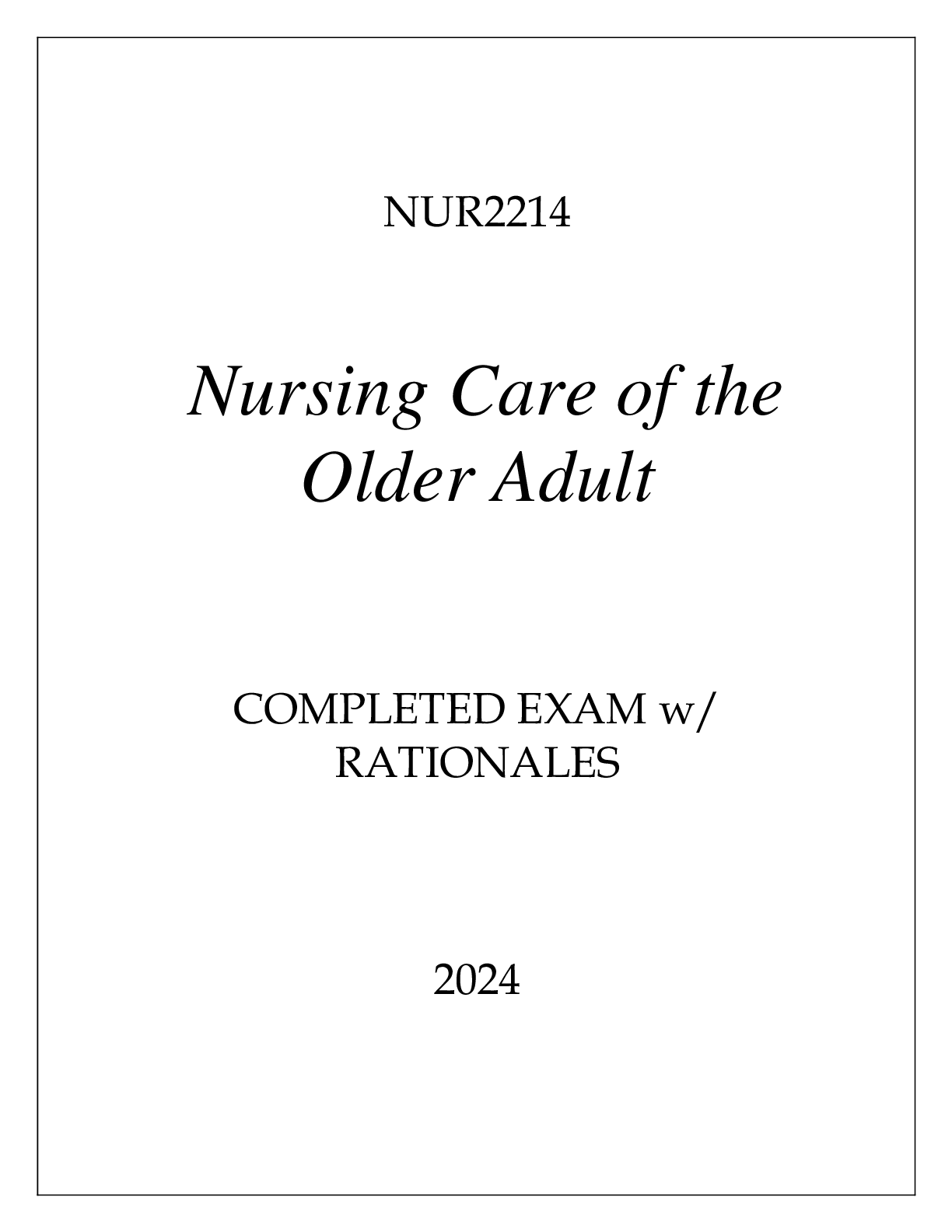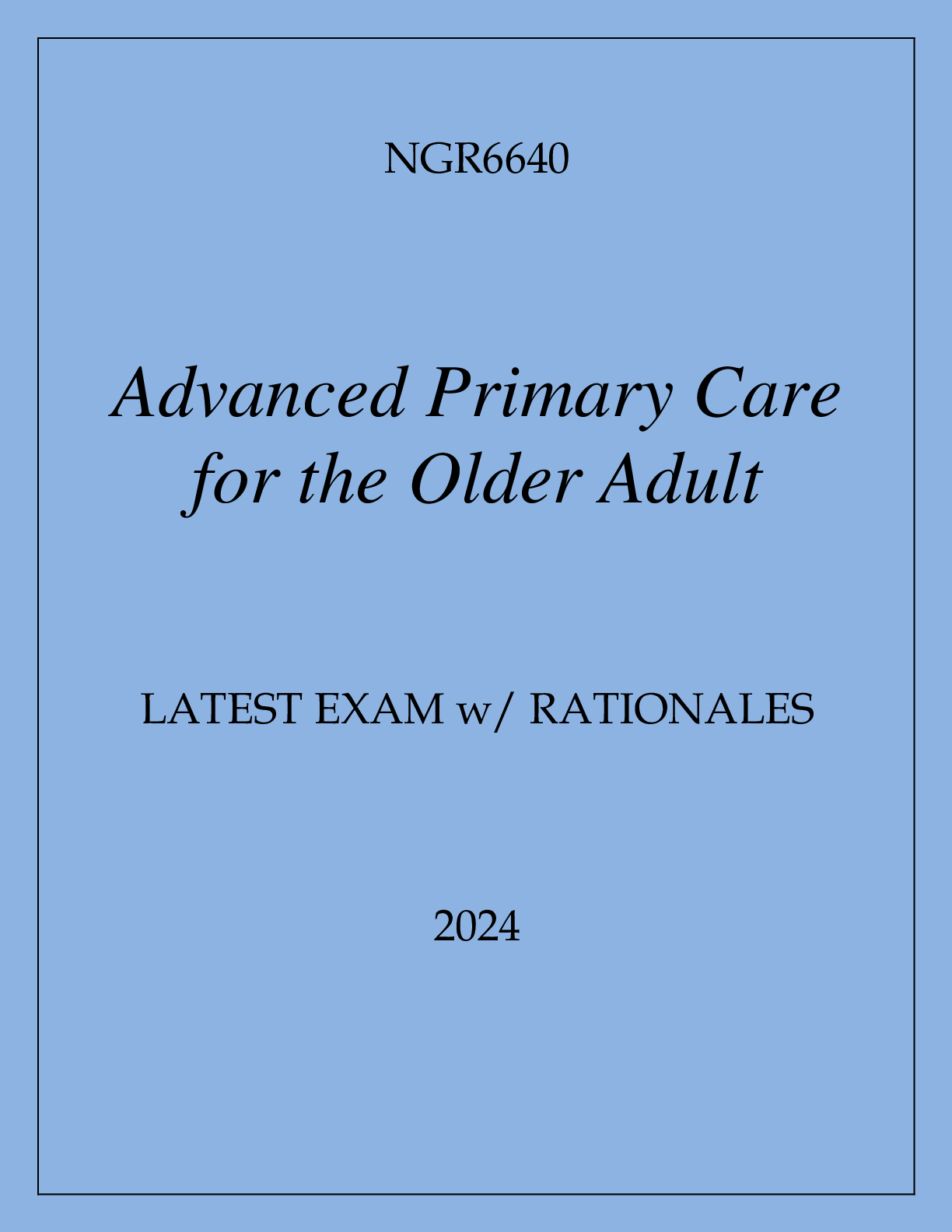*NURSING > EXAM PROCTORED > ATI Nursing care of the child remediation questions LATEST 2020/2021 (All)
ATI Nursing care of the child remediation questions LATEST 2020/2021
Document Content and Description Below
A nurse is reviewing cerebrospinal fluid analysis for a client who has suspected meningitis. Which of the following findings should the nurse identify as indicating viral meningitis? (select all that ... apply.) A.Negative gram stain B.Normal glucose content c.cloudy color D.Decreased WBc count e.Normal protein content A nurse is caring for a 4-month-old infant who has meningitis. Which of the following findings is associated with this diagnosis? A.Depressed anterior fontanel B.constipation c.Presence of the rooting reflex D.High-pitched cry A nurse is creating a plan of care for a newly admitted adolescent who has bacterial meningitis. How long should the nurse plan to maintain the adolescent in droplet precautions? For 24hr following initiation of antimicrobial therapy. A nurse is planning to administer recommended immunizations to a 2‑month‑old infant. Which of the following vaccines should the nurse plan to give? (select all that apply. a.Rotavirus (RV) B.Diphtheria, tetanus, and acellular pertussis (DtaP) C.Haemophilus influenzaetype b (Hib) D.Hepatitis (Hepa) E.Pneumococcal conjugate (PCV13) F.Inactivated poliovirus (IPV) A nurse is assessing a 2½-year-old toddler at a well-child visit. Which of the following findings should the nurse report to the provider? a.Height increased by 7.5 cm (3 in) in the past year. B.Head circumference exceeds chest circumference. C.anterior and posterior fontanels are closed. d.Current weight equals four times the birth weigh A nurse is planning to administer recommended immunizations to a 4‑year‑old child. Which of the following vaccines should the nurse plan to give? (select all that apply.) a.Inactivated poliovirus (IPV) B.Haemophilus influenzaetype b (Hib) C.measles, mumps, rubella (mmR) D.Varicella (VaR) E.Hepatitis B (HepB) F.Diphtheria, tetanus, and acellular pertussis (Dtap) A nurse is caring for a child who is dying. Which of the following are findings of impending death? (Select all that apply.) a.heightened sense of hearing B.tachycardia C.Difficulty swallowing D.Sensation of being cold e.Cheyne‑Stokes respirations A nurse is teaching a parent of a preschool child about factors that affect the child’s perception of death. Which of the following factors should the nurse include in the teaching? a.Preschool children have no concept of death. B.Preschool children perceive death as temporary. C.Preschool children often regress to an earlier stage of behavior. D.Preschool children experience fear related to the disease process A nurse is planning care for an infant who has diaper dermatitis. Which of the following actions should the nurse include in the plan of care? (select all that apply.) Use superabsorbent disposable diapers to reduce skin exposure. a.apply talcum powder with every diaper change. B.allow the buttocks to air dry. c.Use commercial baby wipes to cleanse the area. D.Use cloth diapers until the rash is gone. e.apply zinc oxide ointment to the affected area. PKU is an inherited metabolic disorder in which the newborn lacks the enzyme phenylalanine hydroxylase. This enzyme converts phenylalanine, an essential amino acid, into tyrosine. The lack of this enzyme leads to the accumulation of phenylalanine in the newborn’s bloodstream and tissues, which causes cognitive impairment Initiate dietary restrictions as soon as PKU is diagnosed, or within 7 to 10 days of birth. Place newborn on a formula low in phenylalanine. Intake should be 20 to 30 mg phenylalanine per kilogram of body weight per day. Monitor phenylalanine level. Goal is a phenylalanine level between 2 and 8 mg/dL. Monitor phenylalanine levels in newborns who are breastfeeding. Breast milk contains phenylalanine, so exclusively breastfeeding might not be possible. Monitor the newborn for findings of PKU. Provide parents with education and support. Consult with a registered dietitian. Provide referrals to support groups A nurse is instructing a client who has celiac disease about foods to avoid. Which of the following foods should the nurse include in the teaching? Encourage clients to eat foods that are gluten‑free: milk, cheese, rice, corn, eggs, potatoes, fruits, vegetables, fresh meats and fish, dried beans a.Potatoes B.Graham crackers C.Wild rice D.Canned pears Instruct clients to take tetracyclines (except for minocycline) on an empty stomach with 8 oz water. It may be taken with food if gastric distress occurs. Both minocycline and doxycycline increase the risk of digoxin toxicity. Tell clients not to take tetracyclines just before lying down because it increases the risk of esophageal ulceration. Instruct clients to maintain a 2‑hr interval between ingestion of chelating agents and tetracyclines. Instruct clients to complete the entire course of therapy, even though manifestations may resolve sooner. Advise using additional contraception. A nurse is assessing an infant who has heart failure. Which of the following findings should the nurse expect? (select all that apply.) a.Bradycardia B.Cool extremities C.Peripheral edema d.increased urinary output e.Nasal flaring Administer digoxin every 12 hr. Direct oral elixir toward the side and back of mouth when administering. Give water following administration to prevent tooth decay if the child has teeth. If a dose is missed, do not give an extra dose or increase the next dose. If the child vomits, do not re‑administer the dose. Observe for signs of digoxin toxicity (decreased heart rate, decreased appetite, nausea, vomiting). Notify the provider if these occur. Keep the medication in a locked cabinet. A nurse is providing teaching to the parent of a child who has a new prescription for liquid oral iron supplements. Which of the following statements by the parent indicates an understanding of the teaching? a.“i should take my child to the emergency department if his stools become dark.” B.“my child should avoid eating citrus fruits while taking the supplements.” c.“i should give the iron with milk to help prevent an upset stomach.” D.“my child should take the supplement through a straw. The FLaCC pain assessment scale is recommended for infants and children between 2 months and 7 years of age. A nurse is preparing a toddler for an intravenous catheter insertion using atraumatic care. Which of the following actions should the nurse take? (Select all that apply.) a.explain the procedure using the child’s favorite toy. B.ask the parents to leave during the procedure. C.Perform the procedure with the child in his bed. D.allow the child to make one choice regarding the procedure. e.apply lidocaine and prilocaine cream to three potential insertion sites A nurse is developing a plan of care for a newborn who has hyperbilirubinemia and is to undergo phototherapy. Which of the following actions should the nurse include in the plan of care? a.Reposition the newborn every 4 hr .B.lotion the newborn’s skin twice per day. C.Check the newborn’s temperature every 8 hr. D.Remove the newborn’s eye mask during feedings. A nurse is providing preconception teaching with a client who has phenylketonuria (pKU). Which of the following information should the nurse include in the teaching? a.follow a low‑phenylalanine diet once pregnancy is confirmed. B.the client will undergo testing of phenylalanine levels one to two times per week throughout pregnancy. C.increase intake of dietary proteins prior to conception. D.the client will require a cesarean section birth due to the likelihood of having a fetus with macrosomia. A nurse is reviewing the diagnostic findings for a preschool age child who is suspected of having cystic fibrosis. Which of the following findings should the nurse identify as an indication of cystic fibrosis? A.sweat chloride content 85 mEq/L b.increased serum levels of fat‑soluble vitamins C.72 hr stool analysis sample indicating hard, packed stools D.Chest x‑ray negative for atelectasis A nurse is performing an admission assessment for a child who has cystic fibrosis. Which of the following findings should the nurse expect? (select all that apply.) A.Wheezing b.Clubbing of fingers and toes C.barrel‑shaped chest D.thin, watery mucus E.rapid growth spurts A nurse is caring for a client in a long‑term care facility who is receiving enteral feedings via an Ng tube. Which of the following actions should the nurse complete prior to administering the tube feeding? (select all that apply.) a.auscultate bowel sounds. b.assist the client to an upright position. c.test the pH of gastric aspirate. d.Warm the formula to body temperature. E.discard any residual gastric contents A nurse is caring for a school‑age child who has juvenile idiopathic arthritis. Which of the following home care instructions should the nurse include in the teaching? (select all that apply.) a.Provide extra time for completion of aDls. B.use cold compresses for joint pain. C.take ibuprofen on an empty stomach. D.remain home during periods of exacerbation e.Perform range‑of‑motion exercises. Educate the child and family about the procedure, and provide support. Instruct the child and family not to wash off marks on skin that outline the targeted areas. Teach the child and family to wash the marked areas with lukewarm water, use hands instead of a washcloth, pat dry, and take care not to remove the markings. Avoid using hot or cold water. Teach the child and family to avoid use of soaps, creams, lotions, and powders unless they are prescribed. Encourage wearing loose cotton clothing. Remind the child and family to keep the areas protected from the sun by wearing a hat and long‑sleeved shirts. Instruct the family to seek medical care for blisters, weeping, and red/tender skin A nurse is assessing a child who has epiglottitis. Which of the following findings should the nurse expect? (select all that apply.) A.Hoarseness and difficulty speaking B.difficulty swallowing c.low‑grade fever d.drooling e.dry, barking cough f.stridor A nurse is caring for a child who has bronchiolitis. Which of the following actions should the nurse take? (select all that apply.) A.Administer oral prednisone. B.Initiate chest percussion and postural drainage. c.Administer humidified oxygen. d.suction the nasopharynx as needed. e.Administer oral penicillin For cleft palate Change the infant’s position frequently to facilitate drainage and breathing. The infant may be placed on the abdomen in the immediate postoperative period. Maintain IV fluids until the infant is able to eat and drink. Clear liquid diet for first 24 hr. Avoid placing a straw, tongue depressor, hard pacifier, rigid utensils, hard‑tipped sippy cups, or suction catheters in the infant’s mouth after cleft palate repair. Elbow restraints can needed to be used to prevent the infant from injuring the repair Close observation for signs of airway obstruction, hemorrhage, and laryngeal spasm. Face mask to deliver oxygen. POSTOPERATIVE NURSING ACTIONS●Assess respiratory status, and maintain airway.●Provide supplemental oxygen as prescribed.●Obtain vital signs.●Administer analgesics for pain as prescribed.●Assess surgical site for bleeding or other abnormalities.●Assess bowel sounds and bowel function.●Administer IV fluids and antibiotics as prescribed.●Maintain NPO status.●Maintain NG tube to low continuous suction.●Provide wound care for open surgical sites with wound irrigations with antibacterial solution or saline‑soaked gauze as prescribed.●Provide drain care.●Assess for peritonitis.◯Fever◯Sudden increase in pain◯Irritability ◯Rigid abdomen◯Abdominal distention◯Tachycardia◯Rapid, shallow breathing◯Pallor ◯Chills A nurse is assessing an infant who has heart failure. Which of the following findings should the nurse expect? (select all that apply.) a.Bradycardia B.Cool extremities C.Peripheral edema d.increased urinary output e.Nasal flaring A nurse is caring for a child who is in skeletal traction. Which of the following actions should the nurse take? (select all that apply.) a.remove the weights to reposition the client. B.assess the child’s position frequently. c.assess pin sites every 4 hr D.ensure the weights are hanging freely. e.ensure the rope’s knot is in contact with the pulley. Osteomyelitis= My child will receive antibiotics for several weeks. A nurse is assessing a client who has a new diagnosis of celiac disease. Which of the following clinical manifestations should the nurse expect? Steatorrhea- these patients are unable to digest gluten. A nurse is caring for an infant whose screening test reveals that he might have sickle cell disease. Which of the following tests should be performed to distinguish if the infant has the trait or the disease? a.sickle solubility test B.Hemoglobin electrophoresis c.complete blood count D.transcranial Dopple Sickle‑cell crisis Hgb: decreased WBC count: elevated Bilirubin and reticulocyte levels: elevated Peripheral blood smear reveals sickled cells Celiac Disease expected finding Steatorrhea [Show More]
Last updated: 2 years ago
Preview 1 out of 6 pages

Buy this document to get the full access instantly
Instant Download Access after purchase
Buy NowInstant download
We Accept:

Reviews( 0 )
$13.00
Can't find what you want? Try our AI powered Search
Document information
Connected school, study & course
About the document
Uploaded On
Mar 09, 2021
Number of pages
6
Written in
Additional information
This document has been written for:
Uploaded
Mar 09, 2021
Downloads
0
Views
116


.png)
